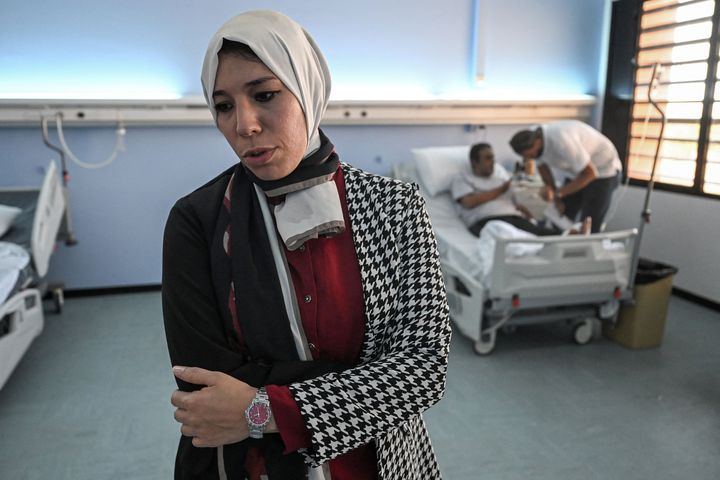
DERNA, Libya (AP) — Officials warned Monday that a disease outbreak in Libya’s northeast, where floods have killed thousands, could create “a second devastating crisis” as adults and children fell ill from contaminated water.
In a statement, the United Nations Support Mission in Libya said it was particularly concerned about water contamination and the lack of sanitation after two dams collapsed during Mediterranean storm Daniel, sending a wall of water gushing through the eastern city of Derna on Sept. 11. The death toll has varied, with government officials and aid agencies giving tallies ranging from about 4,000 to 11,000 dead.
Nine U.N. agencies responding to the disaster are working to prevent diseases from taking hold and creating another crisis in the devasted country, which is receiving 28 tons (25 metric tonnes) of medical supplies from the World Health Organization, the mission said.
Haider al-Saeih, head of Libya’s Center for Combating Diseases, said in televised comments Saturday that at least 150 people — 55 of them children — suffered diarrhea after drinking contaminated water in Derna.
The disaster has brought some rare unity to oil-rich Libya, which has been divided between rival administrations since 2014. Both are backed by international patrons and armed militias whose influence in the country has ballooned since a NATO-backed Arab Spring uprising toppled autocratic ruler Moammar Gadhafi in 2011.
The opposing governments have both deployed humanitarian teams to the port city and other affected areas, but poor coordination, difficulty getting aid to the hardest-hit areas and the destruction of Derna’s infrastructure, including several bridges, have hampered their efforts.
On Monday, protesters gathered outside the al-Shabana mosque in central Derna, in a show of anger against authorities.
Hundreds of Libyan men gathered outside, and atop, the mosque before a man read a list of demands at the building’s entrance. The man called on authorities to expedite their investigation into the disaster, for the U.N to set up an office in Derna, for urgent reconstruction of the city and for compensation for those affected by the flood. After he finished, the hundreds gathered began chanting: “Libya, Libya, Libya.”
On Saturday, Libya’s general prosecutor, al-Sediq al-Sour, opened an investigation into the collapse of the two dams, built in the 1970s, as well as the allocation of maintenance funds. Derna’s mayor, Abdel-Moneim al-Gaithi, was suspended pending an investigation into the disaster.
Later Monday evening, the former mayor said his home was set on fire by protesters. He told the AP that neither he or any of his family members were hurt in the attack but gave no further information.
The same evening, the White House said in a statement that the U.S. will provide an additional $11 million of aid to local and international organizations responding to humanitarian needs.
The International Organization for Migration said Monday that about 40,000 people have been displaced across northeast Libya, including 30,000 in Derna. Residents from the nearby cities of Benghazi and Tobruk have offered to put up the displaced, while volunteers search for survivors buried beneath the rubble.
When the flood struck, Mraje Kdour and his three brothers managed to escape the second floor, but his sister didn’t make it.
“We got so close to the ceiling. We were barely able to breathe,” Kdour told The Associated Press.
The health minister from Libya’s eastern government, Othman Abduljaleel, said Sunday that his ministry had begun a vaccination program “against diseases that usually occur after disasters such as this one” but didn’t elaborate.
Libya’s Red Crescent has said at least 11,300 people have been killed and an additional 10,000 are missing. After earlier reporting that same death toll, the U.N. Office for the Coordination of Humanitarian Affairs is now citing far lower numbers, with about 4,000 people killed and 9,000 missing.
Abduljaleel said at least 3,338 bodies had been identified and buried as of Monday night. He didn’t give an figure for how many bodies had been retrieved but previously tallied the figure at 2,000 Thursday.
Last week, Derna’s mayor said the toll could reach 20,000 dead.
Meanwhile, the floods have raised concerns about the ruins of Ceyrene, an ancient Greco-Roman city roughly 37 miles (60 kilometers) east of Derna that is one of five Libyan UNESCO World Heritage sites.
“UNESCO is in contact with archaeologists on the ground and its satellite imaging team is also trying to establish what the damage might be,” the agency said Monday in a statement sent to the AP.
___
Jeffery reported from London. Associated Press journalist Jamey Keaten in Geneva contributed to this report.
